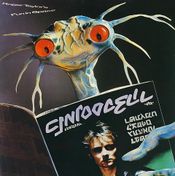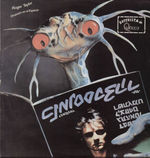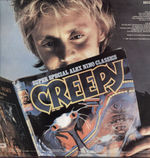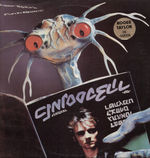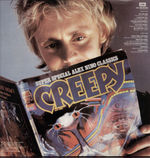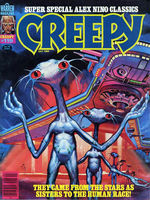From Queenpedia.com
Being the third major songwriter in a quartet of four strong songwriters, it's not surprising that Roger pursued a solo career so quickly and with such determination. He had been the first to issue a solo single (I Wanna Testify, c/w Turn On The TV, in the summer of 1977) and was keen on exploring the limitations of his songwriting and musical ability. During sessions for Jazz in the summer of 1978, Roger started recording ideas for a solo record, which finally would materialize in April 1981, following almost three years of discontinuous work. As far as debut albums go, Fun In Space is a curio; most rock stars of Roger's stature would have employed a host of guest musicians for a booze- and substance-fuelled mammoth recording session, resulting in an album that sounds like it was more fun to make that it is to listen to. Happily, Fun In Space is about as solo as the definition will allow: Roger performed all the instruments (apart from half of the synthesizer arrangements), handled all the vocals, and wrote and arranged all the songs himself, proving that he was especially adept at various instruments as well as vocally carrying an entire album. The songs that make up the album weren't necessarily rejected Queen songs, though Roger did point out in an interview that The Game was almost a double album, what with all the songs that were submitted (but probably not recorded) during that period, so it's likely that some of the songs that ended up on Fun In Space were tried out during sessions for The Game. Reportedly, Freddie name-checked Magic Is Loose as one song from the album that he particularly liked and even sang periodically. The two epics on the album, My Country I & II and the title track, parallel any of the other loftier, ambitious pieces that Freddie and Brian had written in the early stages of their career, while the album has its fair share of rockers, and even an uncharacteristic ballad (Laugh Or Cry). For good measure, a bit of Flash Gordon sci-fi was incorporated onto the second side in Interlude In Constantinople. The album was released during a period of relative change in Queen's career: the band had just completed their first-ever South American tour, and were about to take a brief break from the road before working on their follow-up to The Game. Fun In Space was preceded by a single, the reggae-ish Future Management, by a fortnight, which was relatively well-received and even made an appearance in the UK charts at #49. Subsequent singles ( My Country in the UK and Let's Get Crazy in the US) weren't quite as successful, but the whole experience left an overall positive taste in Roger's mouth, and while he – and the others – always asserted that Queen was their top priority, Roger was more than happy to duck into a recording studio and lay down some songs during extended periods of inactivity in Queen's schedule. Tracklists
Credits
Charts
Information supplied by Fedepeti, 24 August 2004 Singles
Liner notesAll influences - conscious, subconscious and unconscious. P.S. Hello listeners. I hope you enjoy and have fun with this, my very own album. I like it. If you don't, sod you! P.P.S. 157 synthesizers. Thank you: Crystal - for ribaldry, oafishness and carrying me home. Ratty - for his helpfull rodent ways. David Richards - for help, encouragement and ideas. Aline Jacottet - for organising and bailing us out. Andre Jauchet - for co-engineering 'Airheads' and maintenance. Thanks very much to Warren Publishing Co. for the use of Creepy magazine and its illustration. "Alien" illustration by Jim Laurier. Alien monster made by Alistair Bowtell. Sleeve design: Hipgnosis. Photography: Peter Christopherson and Paul Maxon. Graphics: Ian Wright. Illustrations by: Colin Chambers, Jeff Cummins, Colin Elgie, Gill Furmanovsky, George Hardie, Paul Maxon, Ian Wright. Roger talks“In the past, I have written so many songs that it was impossible to put them on a Queen album. So a solo album was the only possibility. There were certain things I wanted to do which weren’t within the Queen format; in a way, it’s like flushing out your system, and until you’ve done it you just don’t feel fulfilled. If I get more ideas for songs I might eventually do another solo thing, but Queen would always get priority.” “Yes, [the diversity of the material is] probably the only weak point, where the critics might accuse me. But on my first solo album I took the opportunity to show my whole spectrum. The second album will be more New Wave.” “There are different reasons [why I played all the instruments]. First, I have my own ideas how the songs should sound. It’s more important to show several abilities of my own. In the end I don’t want to spend my life being behind the drums. There are lots of other drummers who show that solo albums are not only an affair of guitar-players, singers or keyboard-players.” “[The alien on the cover is] called Ernie and comes from an American Comic series. I like the little beast that much, that I use it as a logo.” (Incidentally, the alien creature was a model, and had been designed by Tim Staffell, who had no idea what project the monster was for or to whom it was connected.) “The title Fun In Space doesn’t mean that the album should be regarded as Son Of Flash Gordon, but in many ways it is nostalgic, capturing the old days when life was perhaps a little more uncertain. I’ve got some old sci-fi books and magazines which I browse through from time to time. Maybe there are things up there in space watching us. I wouldn’t find that surprising at all.” ReviewsMelody Maker, 1981 Reveling in bombastic arrogance, so redolent of Queen. A rich man’s self-indulgence run riot over two sides of an album. Record Mirror, 1981 This is Son Of Flash Gordon; it has similar comic book style characteristics. Listening to this is the most fun you’ll have apart from playing Space Invaders.
Sleeves |
|||||||||||||||||||||||||||||||||||||||||||||||||||||||||||||||||||||
